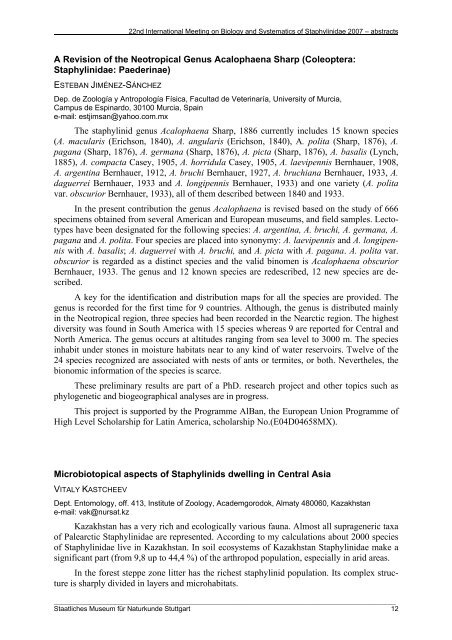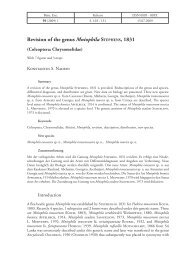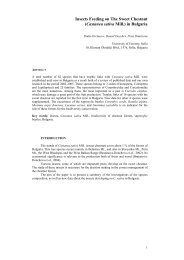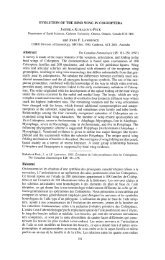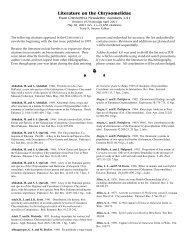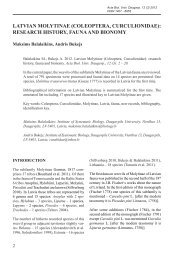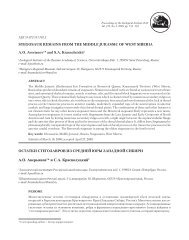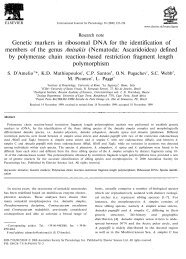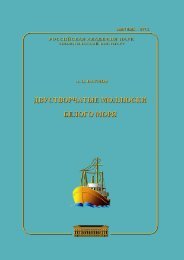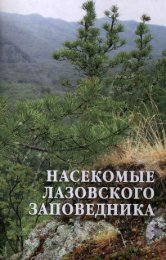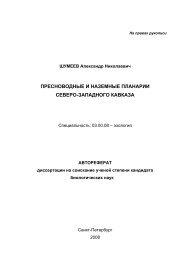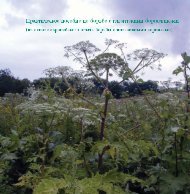International Meeting on Biology and Systematics of Staphylinidae
International Meeting on Biology and Systematics of Staphylinidae
International Meeting on Biology and Systematics of Staphylinidae
Create successful ePaper yourself
Turn your PDF publications into a flip-book with our unique Google optimized e-Paper software.
22nd <str<strong>on</strong>g>Internati<strong>on</strong>al</str<strong>on</strong>g> <str<strong>on</strong>g>Meeting</str<strong>on</strong>g> <strong>on</strong> <strong>Biology</strong> <strong>and</strong> <strong>Systematics</strong> <strong>of</strong> <strong>Staphylinidae</strong> 2007 – abstracts<br />
A Revisi<strong>on</strong> <strong>of</strong> the Neotropical Genus Acalophaena Sharp (Coleoptera:<br />
<strong>Staphylinidae</strong>: Paederinae)<br />
ESTEBAN JIMÉNEZ-SÁNCHEZ<br />
Dep. de Zoología y Antropología Física, Facultad de Veterinaría, University <strong>of</strong> Murcia,<br />
Campus de Espinardo, 30100 Murcia, Spain<br />
e-mail: estjimsan@yahoo.com.mx<br />
The staphylinid genus Acalophaena Sharp, 1886 currently includes 15 known species<br />
(A. macularis (Erichs<strong>on</strong>, 1840), A. angularis (Erichs<strong>on</strong>, 1840), A. polita (Sharp, 1876), A.<br />
pagana (Sharp, 1876), A. germana (Sharp, 1876), A. picta (Sharp, 1876), A. basalis (Lynch,<br />
1885), A. compacta Casey, 1905, A. horridula Casey, 1905, A. laevipennis Bernhauer, 1908,<br />
A. argentina Bernhauer, 1912, A. bruchi Bernhauer, 1927, A. bruchiana Bernhauer, 1933, A.<br />
daguerrei Bernhauer, 1933 <strong>and</strong> A. l<strong>on</strong>gipennis Bernhauer, 1933) <strong>and</strong> <strong>on</strong>e variety (A. polita<br />
var. obscurior Bernhauer, 1933), all <strong>of</strong> them described between 1840 <strong>and</strong> 1933.<br />
In the present c<strong>on</strong>tributi<strong>on</strong> the genus Acalophaena is revised based <strong>on</strong> the study <strong>of</strong> 666<br />
specimens obtained from several American <strong>and</strong> European museums, <strong>and</strong> field samples. Lectotypes<br />
have been designated for the following species: A. argentina, A. bruchi, A. germana, A.<br />
pagana <strong>and</strong> A. polita. Four species are placed into syn<strong>on</strong>ymy: A. laevipennis <strong>and</strong> A. l<strong>on</strong>gipennis<br />
with A. basalis; A. daguerrei with A. bruchi, <strong>and</strong> A. picta with A. pagana. A. polita var.<br />
obscurior is regarded as a distinct species <strong>and</strong> the valid binomen is Acalophaena obscurior<br />
Bernhauer, 1933. The genus <strong>and</strong> 12 known species are redescribed, 12 new species are described.<br />
A key for the identificati<strong>on</strong> <strong>and</strong> distributi<strong>on</strong> maps for all the species are provided. The<br />
genus is recorded for the first time for 9 countries. Although, the genus is distributed mainly<br />
in the Neotropical regi<strong>on</strong>, three species had been recorded in the Nearctic regi<strong>on</strong>. The highest<br />
diversity was found in South America with 15 species whereas 9 are reported for Central <strong>and</strong><br />
North America. The genus occurs at altitudes ranging from sea level to 3000 m. The species<br />
inhabit under st<strong>on</strong>es in moisture habitats near to any kind <strong>of</strong> water reservoirs. Twelve <strong>of</strong> the<br />
24 species recognized are associated with nests <strong>of</strong> ants or termites, or both. Nevertheles, the<br />
bi<strong>on</strong>omic informati<strong>on</strong> <strong>of</strong> the species is scarce.<br />
These preliminary results are part <strong>of</strong> a PhD. research project <strong>and</strong> other topics such as<br />
phylogenetic <strong>and</strong> biogeographical analyses are in progress.<br />
This project is supported by the Programme AlBan, the European Uni<strong>on</strong> Programme <strong>of</strong><br />
High Level Scholarship for Latin America, scholarship No.(E04D04658MX).<br />
Microbiotopical aspects <strong>of</strong> Staphylinids dwelling in Central Asia<br />
VITALY KASTCHEEV<br />
Dept. Entomology, <strong>of</strong>f. 413, Institute <strong>of</strong> Zoology, Academgorodok, Almaty 480060, Kazakhstan<br />
e-mail: vak@nursat.kz<br />
Kazakhstan has a very rich <strong>and</strong> ecologically various fauna. Almost all suprageneric taxa<br />
<strong>of</strong> Palearctic <strong>Staphylinidae</strong> are represented. According to my calculati<strong>on</strong>s about 2000 species<br />
<strong>of</strong> <strong>Staphylinidae</strong> live in Kazakhstan. In soil ecosystems <strong>of</strong> Kazakhstan <strong>Staphylinidae</strong> make a<br />
significant part (from 9,8 up to 44,4 %) <strong>of</strong> the arthropod populati<strong>on</strong>, especially in arid areas.<br />
In the forest steppe z<strong>on</strong>e litter has the richest staphylinid populati<strong>on</strong>. Its complex structure<br />
is sharply divided in layers <strong>and</strong> microhabitats.<br />
__________________________________________________________________________________________<br />
Staatliches Museum für Naturkunde Stuttgart 12


